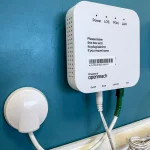Eutelsat OneWeb in First Successful Trial of a 5G Non-Terrestrial Network

European satellite operator Eutelsat has announced that their OneWeb network, which is a global constellation of broadband satellites in Low Earth Orbit (LEO) that is partly still supported by the UK government (11% stake), has just conducted the “world’s first successful trial” of a 5G Non-Terrestrial Network (NTN).
OneWeb (aka – Eutelsat OneWeb) currently has 654 small (c.150kg) first generation (GEN1) LEO platforms in space – orbiting at an altitude of 1,200km (c.600 of them for coverage and the rest for redundancy). The network was completed in March 2023 (here), promising both ultrafast broadband speeds and fast latency times. But a further 15 satellites (plus one GEN2 prototype) were then launched in May 2023 to add “resiliency and redundancy to the network” (here) and then 20 more in October 2024 (here).
However, Eutelsat has long held an ambition to adopt mobile (5G) communications support into their satellite network, which would use the Non-Terrestrial Networks (NTNs) standard within the 5G specification (3GPP Release 17). The latest test using a live commercial network is thus said to “pave the way for deployment of the 5G NTN standard, which will result in future satellite and terrestrial interoperability within a large ecosystem, lowering the cost of access and enabling the use of satellite broadband for 5G devices around the world“.
Advertisement
The trial used OneWeb satellites, with the MediaTek NR [5G New Radio] NTN test chipset, and NR NTN test 5G g-NodeB (gNB) provided by ITRI, implementing the 3GPP Release 17 specifications. Sharp, Rhode & Schwarz provided the antenna array and test equipment and the LEO satellites, built by Airbus, carry transponders, with Ku-band service link, Ka-band feeder link, and adopting the “Earth-moving beams” concept.
During the trial, the 5G user terminal successfully connected to the 5G core via the satellite link and exchanged traffic. “With the integration of 5G standards shared and accepted by the entire mobile industry, all compatible satellite constellations will naturally and seamlessly complement terrestrial networks, enabling truly ubiquitous connectivity with economies of scale, and opening up new markets for smartphones, the automotive industry and the Internet-of-Things,” said Eutelsat.
Arlen Kassighian, Chief Engineering Officer at Eutelsat Group, said:
“These trials show the commitment of Eutelsat Group in developing and adopting new technologies, in order to provide the best possible services to our customers, in collaboration with trusted partners. 5G NTN will be a key feature of the IRIS2 constellation, and Eutelsat is at the forefront of this innovation and active member of the ecosystem. We are proud to be the first satellite operator to demonstrate the 5G air interface working on a commercial fleet in Ku-band and paving the way for new applications in future constellations.”
In case anybody has forgotten, OneWeb conducted a related test back in October 2023 (here), although Eutelsat’s latest test is much closer to a final commercial product. The 2023 trial saw a team at the University of Surrey test a 5G mobile network by connecting Surrey’s 5G core to a cell site through the LEO constellation. But that wasn’t the same approach as Starlink or AST Space Mobile are using, where the satellites can directly connect to existing Smartphones (i.e. OneWeb’s original test seemed to be more about providing the backhaul (capacity) for 5G cells, which is still useful).
Mark is a professional technology writer, IT consultant and computer engineer from Dorset (England), he also founded ISPreview in 1999 and enjoys analysing the latest telecoms and broadband developments. Find me on X (Twitter), Mastodon, Facebook, BlueSky, Threads.net and Linkedin.
« Signs of Life as UK Broadband Altnet WhyFibre Spotted Building FTTP






















































It has become apparent that the public will not accept 5G monopoles near homes – this is the way forward.
In the example above, you still have to stick the powered distribution cells somewhere, usually on top of a suitably tall structure (building, mast/pole etc.). Satellites also lack the capacity to completely and affordably replace terrestrial mobile infrastructure.
In reality, most mobile users go for the lowest-cost service. This would more than likely be a premium service offered at a premium price.
none of these direct-to-cell systems are a replacement for ground based infrastructure. It’s great for when you’re in the middle of nowhere (ie, not 99% of the UK) but not as a NIMBY appeasement tool.
The only solution there is political. The government should change the law to ban all the usual objections and allow the MNOs to crack on.
Impressive. Presumably, the offering will be a premium service aimed at the air and sea travel sectors.
how long will it be before musk takes note and demands to buy oneweb
I can’t see that happening or even being approved in this climate (he’d have to buy Eutelsat). But mainly because he has no need. Starink is ahead of OneWeb in many areas, and its satellites just don’t add much to what his network can already deliver.
Starlink is transmitting NR test carriers on some of its satellite constellation in areas where they are not transmitting LTE, so it’s fair to say that it won’t be long before they offer it as a service themselves. I suspect they will use some of the more advanced capabilities to overcome bandwidth and power issues they are facing. Also, Starlink is not using 3GPP NTN capabilities but utilising some pretty slick doppler cancellation and beamforming so that regular devices available today can connect to Starlink.
One thing that does irk me however, is that there are UK companies (who have done some NTN work already) that could have been the space segment gNB generator but as usual this UK taxpayer backed company goes elsewhere to get it’s resources.
Direct to mobile device service’s, will likely only ever be able to deal with a very limited number of calls within a given area. Because of the distances involved, I would think the satellite’s phased array antenna’s will have to use a lot of capacity to provide the directional gain required to deal with just one call; In addition the speed of the satellites will make handoff’s difficult due to line of site issues and varying distances. In my opinion direct to mobile will only ever be useful for out of the way places without terrestrial service. Backhauling through satellites using small solar/battery powered remote cells would be far more doable in my opinion.
AST also did a 5G Video call with Verizon today… https://x.com/AST_SpaceMobile/status/1894042401389621695?t=1US5ALGNIwRjtbc145lctQ&s=19
Seems those Starlink NR tests I referred to above may have been terrestrial – https://www.linkedin.com/posts/michaelthelander_starlink-report-preview-activity-7299763313524031489-FjWI. Very interesting article about the robustness of Starlink LTE though.
StarLink is a long way from being a viable affordable option for most people in the UK.